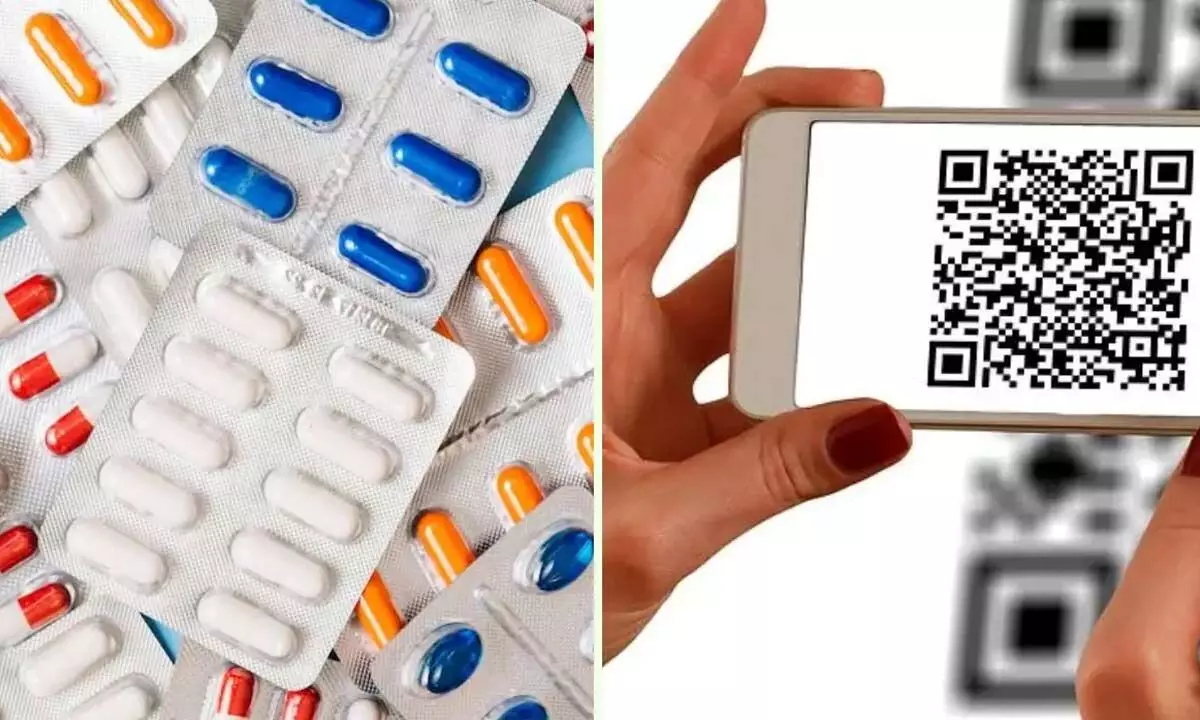QR code will go a long way in checking fake medicines in India
Union Health Ministry has recently amended the Drugs and Cosmetic Rules (D&C Rules), 1945, mandating QR code on the label of top 300 brands of drugs from August 1, 2023
image for illustrative purpose

Under the new sub-rule 6, the manufacturers of drug formulation products specified in the schedule H2 of the rule, shall print or affix Barcode or QR code on its primary packaging label or, in the case of inadequate space in primary package label, on the secondary package label that store data or information legible with software application to facilitate authentication
The Union Health Ministry has recently amended the Drugs and Cosmetic Rules (D&C Rules), 1945, mandating Barcode or Quick Response (QR) Code on the label of top 300 brands of drugs from August 1, 2023. In June this year, the ministry had released the draft rule in which it introduced a new Schedule H2 with a list of 300 top brands, and inserted a new sub-rule 6 under the Rule 96, under the D&C Rules, 1945, after the sub-rule (5).
Under the new sub-rule 6, the manufacturers of drug formulation products specified in the schedule H2 of the rule, shall print or affix Barcode or QR code on its primary packaging label or, in the case of inadequate space in primary package label, on the secondary package label that store data or information legible with software application to facilitate authentication. A sub-rule 7 has also been inserted into the Rules, defining the details thus to be added in the Barcode or QR code. This include the particulars including unique product identification code, proper and generic name of the drug, brand name, name and address of the manufacturer, batch number, date of manufacturing and date of expiry along with the manufacturing license number.
Obviously, the Health Ministry's action will in the long run prove to be a big boost to the pharmaceutical industry's efforts to maintain the authenticity of medicines in the country. In the newly inserted rules, after Schedule H1, the Schedule H2 was inserted containing a list of top 300 brands which will have QR code on the pack from August next year.
The list includes various dosages of Aciloc, Actemra, Actrapid (human insulin), Aerocort, Ajaduo, Allegra, Ambisome, Amicin, Amlokind, Ascoril, Asthakind, Asthalin, Augmentin, Avomine, Axcer, Azee, Azithral, Becosules, Betadine, Betnesol, Betnovate, Bett, Bevon, Bio D3 Max, Brilinta, Bro Zedex, Budecort, Calcirol, Caldikind, Calpol, Candiforce, CCM, Cefakind, Ceftum, Cepodem, Chymoral Forte, Cidmus, Cilacar, Cipremi, Claribid, Clavam, Clexane, Cobadex, Codistar, Combiflam, Concor, Corex, Cremaffin, Cypon, Cyra D, Dalacin C, Deca Durabolin, Defcort, Deriphyllin, Derobin, Dexona, Dexorange, Dolo, Dolonex, Doxinate, DOXT, Doxy 1 Forte, Dulcoflex, Duolin, Duphaston, Dydroboon, Dynapar, Easy Six, Ecosprin, Elaxim, Electral sachet, Eliquis, Eltroxin, Enterogermina, EXHEP, Fabiflu, Faronem, Foracort, Forxiga, Gabapin NT, Galvus, Geftinat, Gelusil MPS, Gemcal. The list also includes varied dosages of Gemer, Gibtulio, Gluconorm, Glycomet, Glynase, Glyxambi, Grilinctus, Gudcef, HCQS, Hexaxim, Hucog HP, Huminsulin, Infanrix Hexa, Istamet, Ivabrad, Ivermectol, Jalra M, Janumet, Januvia, Jardiance, Kabimol, Karvol Plus, Kenacort, Ketorol, Ketosteril, Lantus, Lantus Solostar, Levera, Levipil, Librax, Limcee Chew, Lipaglyn, LMWX, Lobate GM Neo, Lonopin, Losar, Macbery XT, Magnex Forte, Manforce, Maxtra, Meftal Spas, Megalis, Meganeuron OD Plus, Menactra, Mero, Meromac, Meronem, Meroza, Mifegest, Mikacin, Minipress, Mixtard, Monocef, Montair, Montaz, Montek, Monticope, MOX, Moxclav, Moxikind CV, Mucaine Mint, Mucinac SF, Nebicard, Nefrosave, Neurobion Forte, Nexpro, Nikoran, NISE, Nitrocontin, Novomix, Novorapid, Nurokind, O2, Omez, Omnikacin, Ondero, Orofer, Otrivin, Ovral, Oxra. The list further contains various strength of Pan 40, Pan D, Panderm, Pantop, Pantin, Pantocid, Pantodac, Phensedyl, Pipzo, Practin, Prega News, Prevenar 13, R.B Tone, Rablet-D, Rantac, Razo, Refresh Tears, Rejunex-CD3, Remdac, Rosuvas, Ryzodeg, Saridon, Seroflo, Shelcal, Silodal, Sinarest, Skinlite, Sompraz D, Spasmo Proxyvon Plus, Spegra, Stamlo, Stemetil, Sucrafil, Sumo, Supradyn, Synflorix, T BACT, Targocid, Taxim O, Tazomac, Telekast-L, Telma, Telmikind, Thrombophob, Thyronorm, Tossex, Trajenta, Tresiba Flextouch, TUSQ DX, Udiliv, Ultracet, Unienzyme, Unwanted 72, Urimax, Uprise D3, Ursocol, Varilrix, Veloz D, Velpanat, Vertin, Volini, Vorier, Voveran, Vymada, Wysolone, Xone, Zavicefta, Zedex, Zerodol, ZIFI, Zoryl-M, Zostum.
The Health Ministry's latest move is in line with the recommendation of the Drugs Technical Advisory Board (DTAB), the highest authority under the Union Health Ministry on technical matters, in November last year. The DTAB, in its meeting held in November, 2021, had recommended introduction of QR code in the top 300 brands of drug products available in the Indian market to help track and trace these brands, in line with the discussions it has been carrying out in the last couple of years.
Of course, the government's action is an attempt to curb circulation of spurious drugs in the country. The Health Ministry has taken a well considered decision as it will help trace source and affirm authenticity of medicines while also improving patient health and safety. The QR code, which will prevent the sale of counterfeit drugs, will also verify whether a drug is genuine or counterfeit, and will include information such as the company, manufacturer, expiry date, and brand name, among other things. It is a welcome move by the government as the QR codes on the packaging of top 300 brands of life-saving medicines will go a long way in preventing distribution of counterfeit medicines in the country.
(The author is a freelance journalist with varied experience in different fields)

